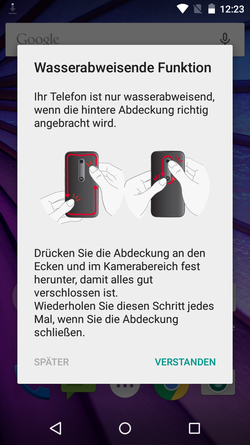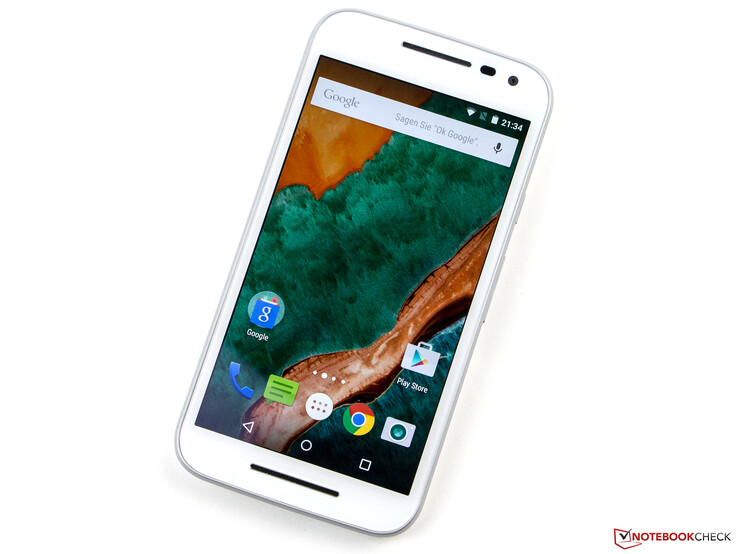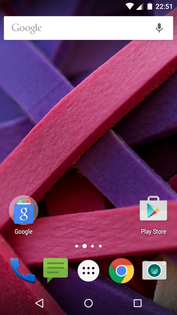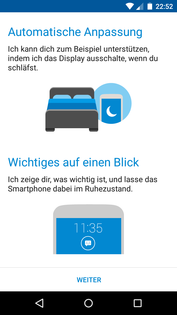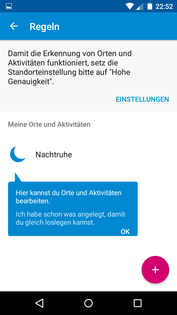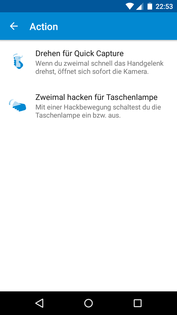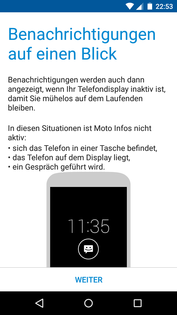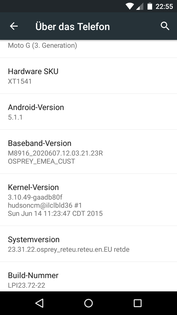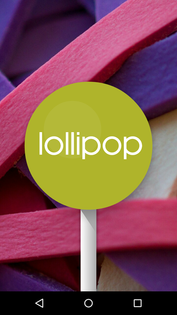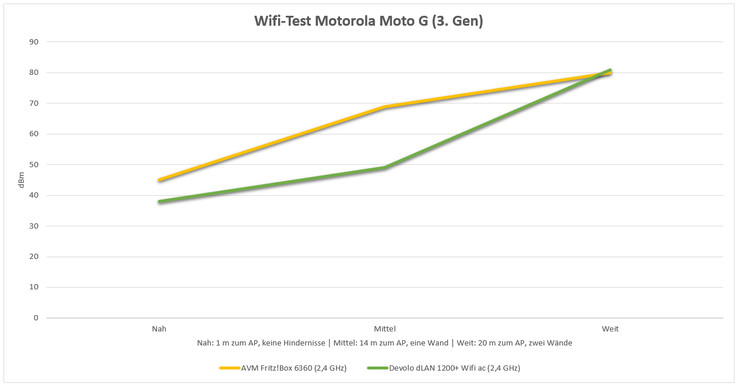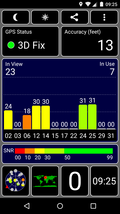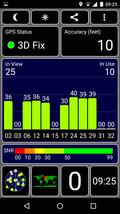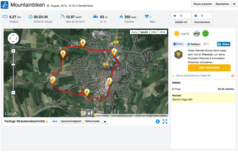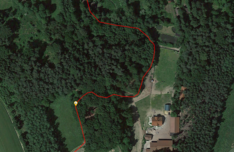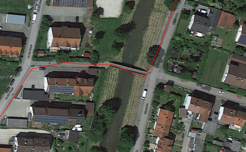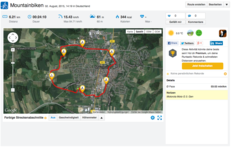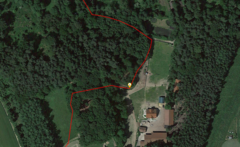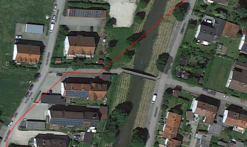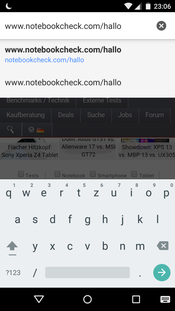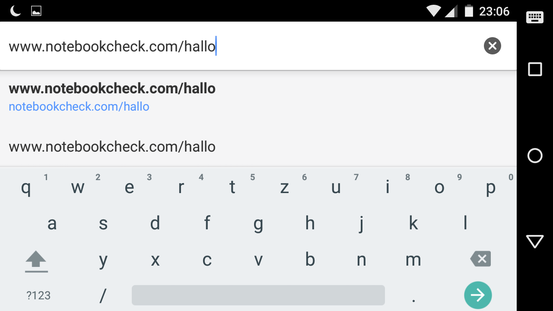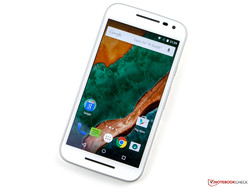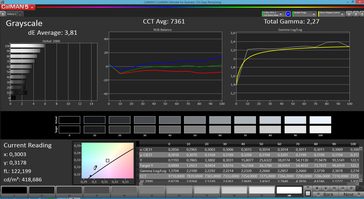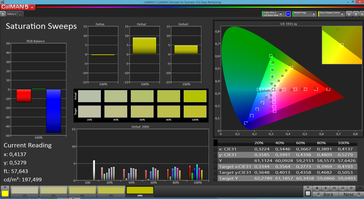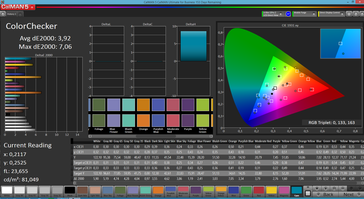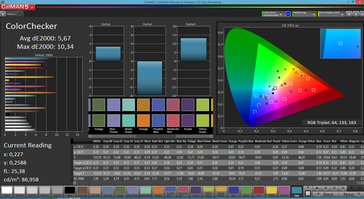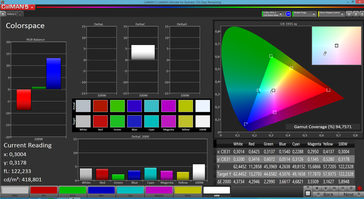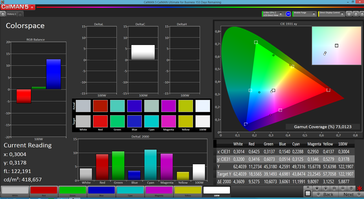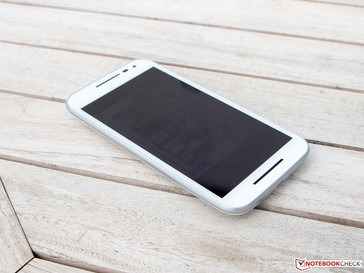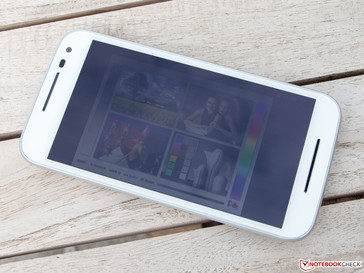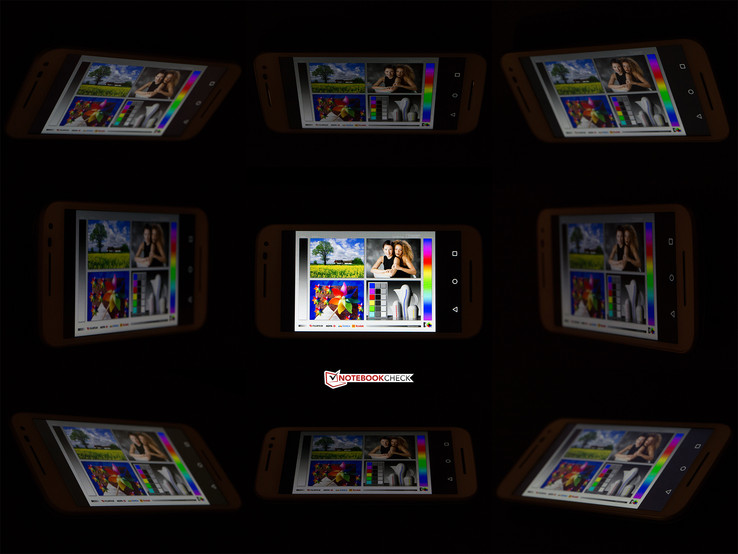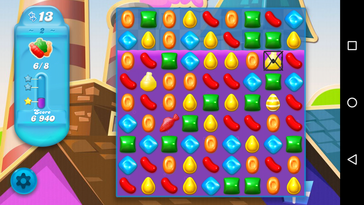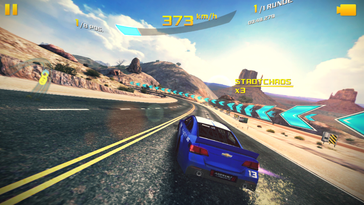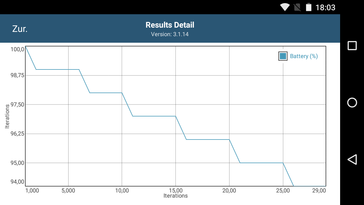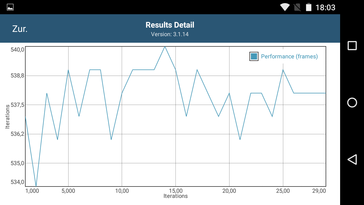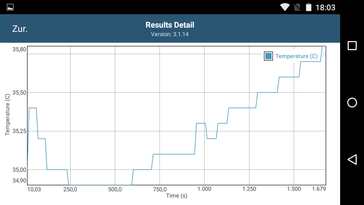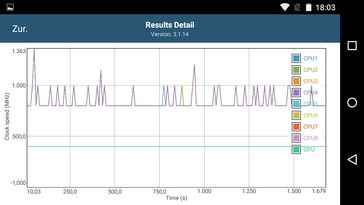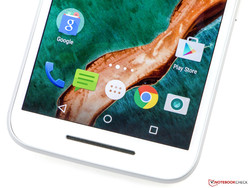Motorola Moto G (3rd Generation) Smartphone Review
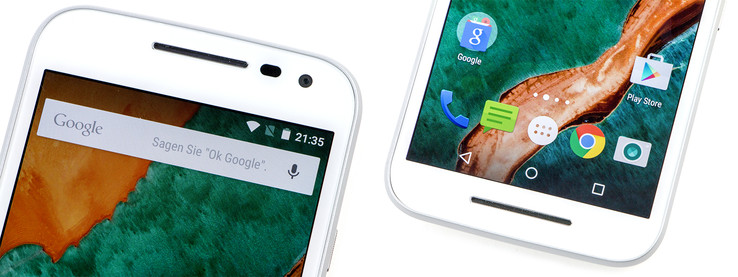
For the original German review, see here.
Since its launch, the Moto G line has been seen as the reference in its price range. Lenovo's subsidiary again delivers a successful product this time. The SoC has only been upgraded slightly. In contrast to the precursor, a Snapdragon 410 clocks inside the smartphone, making it 64-bit capable. There are still two storage capacities to choose from: The first has 8 GB of flash memory and 1 GB of working memory, and the second 16 GB and 2 GB. Motorola has also boosted the price, and the small configuration now costs 249 Euros (~$274), which is roughly 50 Euros (~$55) more than the former model. 30 Euros (~$33) more has to be invested for the higher-storage model. We are testing the smaller device.
The Moto G finds itself in one of the most fiercely contested smartphone sectors, and thus there are plenty of contenders. Among them we find the Huawei P8 Lite, ZTE Blade S6, Microsoft Lumia 640, Wiko Ridge 4G, Sony Xperia M4 Aqua, Asus Zenfone 5, and Samsung Galaxy A3.
Case
Motorola's Moto G (3rd Generation) has grown slightly around all edges, which is likely due to the bigger battery and the moisture-protection seals. Unlike its precursor that only had a nano-protection finish against splash water, the Moto G is now protected against the ingress of fresh water in compliance with IPX7. That means it can be submerged in water up to a depth of one meter for 30 minutes. In contrast to Sony's Xperia M4 Aqua, it is not dust-proof.
The review sample's height ranges from 6.1 to 11.6 millimeters and weighs a high 155 grams. However, neither measurement gets annoying in everyday use. Quite the contrary: The smartphone is pleasant to hold and makes a high-quality impression. The fact that it is made completely of plastic does not change that. The rippled back proves to be very slip-proof. The Moto G also did not make any noises during our warping attempts. Only firm pressure on the screen's Gorilla Glass 3 panel can provoke slight wave formation.
The gaps are exact and do not give reason for complaint. The back also closes flush and homogeneously. The micro-SIM and micro-SD card slots can be accessed after removing the back cover. The battery is hidden underneath another plastic layer and is not as easy to access.
The Moto G does not exhibit any manufacturing weaknesses. The smartphone's outside colors can be personalized when the device is ordered via the Moto Maker.
Connectivity
Motorola does not upgrade the connectivity. Users who want to transmit screen content to a TV without cables will need a Chromecast dongle. The Moto G (2015) does not support DLNA or Miracast. There is no cabled version, either. MHL? Slim port support? Far from it.
The storage can be expanded via the micro-SD card slot. The manufacturer states that it supports cards with a size of up to 32 GB. These specifications are often outdated, and SDXC cards with up to 64 if not 128 GB can be used. This is, unfortunately, not the case in the Moto G. Our test card (Samsung Evo MB-MP64D, 64 GB) was identified but not accepted. Some less expensive contenders do a better job with that. For example, the Lumia 640 supports memory cards with up to 128 GB.
Users who want to connect external storage devices via the micro-USB 2.0 port will also be disappointed. The Moto G does not support OTG, either. We see plenty of room for improvement here.
Software
Following tradition, Motorola also relies on the latest stock Android version in the 3rd generation. Thus, Android 5.1.1 Lollipop is installed. Even additional apps are limited to a minimum, and only the Moto app and an aid for migrating data are preloaded. There are no third-party apps found.
The Moto app is known from other devices, such as the Moto X. It enables defining guidelines for the smartphone according to location or time. Besides that, two gestures can also be enabled that either turn on the flashlight or camera. Furthermore, the screen's notification behavior in standby can be controlled.
Communication & GPS
Motorola's Moto G (2015) accesses the Internet via HSPA+ (max. 42 MBit/s) or LTE Cat.4 (max. 150 MBit/s) on the go. The latter connection has a wide frequency coverage, which, unfortunately, cannot be said of the HSPA alternative. The smartphone usually preferred the LTE connection in the tests. The connection quality was good and did not display any irregularities in a major city.
The smartphone's Wi-Fi module only supports the IEEE 802.11 b/g/n standards and consequently only transmits in the 2.4 frequency band. The components' range is nevertheless decent and largely convincing. However, the signal decreases strongly at a big distance to the access point (AP). It was as much as -83 dBm with a Devolo AP, and -84 dBm with a Fritz!Box. We could, however, enjoy an HD stream via Netflix without interference.
The Moto G 3rd Generation does not sport NFC, either. Bluetooth version 4.0 is again on board and functions impeccably. The connection proved very stable, and audio streaming was possible at a distance of 15 meters between speakers and smartphone without any interruptions.
The Moto G utilizes both the GPS and Glonass satellite networks for localization. It took a moment before satellites were found indoors but was then relatively accurate. It was much faster outdoors and even more precise.
We tested the accuracy of Motorola's Moto G (2015) in everyday use by comparing it with the bike computer Garmin Edge 500. Both devices were taken on the same bike route, and the review sample made a good impression. Although minor localization inaccuracies are seen in narrow streets and in the woods, they are barely noticed in the sum of the test route.
Telephone & Voice Quality
The call quality of Motorola's Moto G (3rd Generation) is decent but not exceptional. It is still far remote from HD telephony, but it is absolutely enough for making calls. While our contact was fairly intelligible, we sounded a bit subdued. Static or dropouts were not noticed. Our voice echoed audibly and sounded a bit more muffled when the phone was placed on a table beside us and the speaker was used, but it was also transported very loudly.
Cameras
Compared with the precursor, the front-facing camera has been beefed up considerably. Its lens now has a resolution of up to 5 MP (1920x2560 pixels) and can fall back on a 72-degree field of view. The photosensitivity of f/2.2 is good, and the lens also supports automatic HDR. Unfortunately, it only has a fixed focus. Daylight shots are quite decent, but that quickly decreases in weak ambient light. Using the screen as a flash replacement will not help much here, either.
The rear-facing camera in the Moto G has also received a few extra megapixels and now achieves 13 MP (4160x3120 pixels; 4:3). Its photosensitivity should also be quite decent with an aperture of f/2.0. Comparatively good photos could be shot in daylight using the smartphone. The pictures were sharp, and the color accuracy also made a good impression. The lens' release delay is crisp and short. It is handy that there is no fixed release on the touchscreen, and it is enough to tap anywhere on the screen.
However, its low-light qualities are not really convincing. Although the pictures are brightened up strongly in dim light, the outlines are visibly frayed. The noise increases intensely, and a photo's brightness decreases rapidly when it gets a bit darker. The dual-LED CCT flash does a relatively good job and does not cool down the colors of the pictures too much. In view of the price range, the review sample sports a really good camera.
The Moto G (2015) can record videos in Full HD (1920x1080 pixels; 16:9; 30 fps). The outcome is quite decent, but a light grayish fog covers the pictures when there is the slightest back light.
Accessories
Motorola's Moto G (2015) is shipped with only several leaflets composed of a quick-start guide and safety instructions, and a USB cable. A power adapter is not included, which should be considered in the purchasing process.
The manufacturer also offers product-specific accessories for the smartphone. For example, additional shells for approximately 15 Euros (~$16) each, or Flip Shells (30 Euros each, ~$33) are sold separately. The former are a bit more expensive than they were for the precursor.
Warranty
Motorola includes a 24-month warranty on its product that cannot be extended.
Input Devices & Handling
Motorola still does not use a proprietary keyboard layout and relies on the stock Android version. Its design is relatively plain and clearly arranged which also makes it appealing. It additionally supports voice commands and swiping. An additional row with automatic word suggestions is also present.
The capacitive touchscreen detects up to ten fingers simultaneously, and its sleek surface is also compelling. The sensitivity up into the corners is very good; the touchscreen only cannot discern two fingers that are pressed together very closely.
Furthermore, the Moto G supports two options for controlling the smartphone using gestures. Double-tapping either turns the flashlight on or off, and double-twisting the wrist launches the camera. The smartphone displays time and possible notifications on the screen when it is picked up and without having to touch it in standby.
Display
Compared with the precursor, the screen of Motorola's Moto G has not changed much. It has a size of 5-inches and the small HD resolution of 1280x720 pixels (16:9). That is still enough for a pixel density of 294 ppi, which is pleasantly sharp. Single pixels are only visible when looking very closely.
The screen's brightness of up to 418 cd/m² is quite good. Solely Sony's Xperia M4 Aqua is considerably brighter (max. 547 cd/m²). The brightness homogeneity is also again on a very good level.
| |||||||||||||||||||||||||
Brightness Distribution: 95 %
Center on Battery: 418 cd/m²
Contrast: 853:1 (Black: 0.49 cd/m²)
ΔE ColorChecker Calman: 3.92 | ∀{0.5-29.43 Ø4.77}
ΔE Greyscale Calman: 3.81 | ∀{0.09-98 Ø5}
Gamma: 2.27
CCT: 7361 K
| Motorola Moto G 3. Gen 2015 XT1541 Adreno 306, 410 MSM8916, 8 GB eMMC Flash | Motorola Moto G 2. Gen XT1068 Adreno 305, 400 MSM8226, 8 GB SSD | Samsung Galaxy A3 Adreno 306, 410 MSM8916, 16 GB eMMC Flash | Huawei P8 lite Mali-450 MP4, Kirin 620, 16 GB eMMC Flash | ZTE Blade S6 Adreno 405, 615 MSM8939, 16 GB eMMC Flash | Sony Xperia M4 Aqua Adreno 405, 615 MSM8939, 8 GB eMMC Flash | Wiko Ridge 4G Adreno 306, 410 MSM8916, 16 GB iNAND Flash | Microsoft Lumia 640 Adreno 305, 400 MSM8226, 8 GB eMMC Flash | |
|---|---|---|---|---|---|---|---|---|
| Screen | -3% | 13% | -14% | -24% | -18% | -34% | 5% | |
| Brightness middle (cd/m²) | 418 | 349 -17% | 434 4% | 365 -13% | 386 -8% | 547 31% | 459 10% | 433 4% |
| Brightness (cd/m²) | 407 | 348 -14% | 433 6% | 353 -13% | 377 -7% | 535 31% | 434 7% | 429 5% |
| Brightness Distribution (%) | 95 | 96 1% | 96 1% | 93 -2% | 90 -5% | 92 -3% | 90 -5% | 95 0% |
| Black Level * (cd/m²) | 0.49 | 0.4 18% | 0.42 14% | 0.44 10% | 0.81 -65% | 0.35 29% | 0.52 -6% | |
| Contrast (:1) | 853 | 873 2% | 869 2% | 877 3% | 675 -21% | 1311 54% | 833 -2% | |
| Colorchecker dE 2000 * | 3.92 | 3.74 5% | 2.98 24% | 5.2 -33% | 7.12 -82% | 5.77 -47% | 9.69 -147% | 3.42 13% |
| Greyscale dE 2000 * | 3.81 | 4.52 -19% | 2.68 30% | 5.85 -54% | 6.7 -76% | 5.87 -54% | 10.8 -183% | 3.03 20% |
| Gamma | 2.27 97% | 2.63 84% | 2.44 90% | 2.17 101% | 1.98 111% | 2.14 103% | 1.82 121% | 2.16 102% |
| CCT | 7361 88% | 7336 89% | 6603 98% | 7252 90% | 7784 84% | 7784 84% | 9063 72% | 7081 92% |
| Color Space (Percent of AdobeRGB 1998) (%) | 70.86 | 72.0875 | ||||||
| Color Space (Percent of sRGB) (%) | 91.25 | 96.5753 |
* ... smaller is better
The contrast of the Moto G has not changed much, either. Its marginally higher black level even places the contrast ratio a bit below that of the precursor. The leader in this section is the Galaxy A3 with its Super AMOLED screen. However, the Wiko Ridge also presents a top rate here.
We analyzed the screen's color accuracy using a photospectrometer and the CalMAN software. The Moto G looks impressive here. The review sample does not surpass DeltaE 4 in either the grayscale levels or mixed colors in the sRGB color space. Only the Galaxy A3 and Lumia 640 are slightly better in the comparison field. The Moto G apparently has the most problems in displaying orange. The shifts are very visible to the eye, but that does not have an adverse effect in everyday use. A very subtle bluish tint is visible in the grayscale levels.
Motorola's Moto G (2015) does quite a good job in outdoor use. Its good contrast ratio ensures good screen legibility in the open air providing it is not too bright. The screen finds its limits under the bright summer sun. There are, however, no problems under lightly overcast skies or in the shade. The smartphone's reflective surface sometimes proves a bit aggravating.
The viewing-angle stability of Motorola's Moto G (2015) is also really good. However, that was to be expected in view of the underlying IPS technology. The image remains stable even in extremely flat viewing angles, and inverting colors are not seen. Only a light IPS glow effect sets in.
Performance
After the last Moto G (Snapdragon 400) did not get a new SoC, the 3rd generation of the smartphone receives a Qualcomm Snapdragon 410 MSM8916 with four Cortex A53 cores that clock at up to 1.4 GHz each. This, unfortunately, is not such a sensational upgrade. A more economic architecture is used with a 200 MHz higher clock and it supports 64 bits. Furthermore, our review sample only has 1 GB of working memory. The Adreno 306 graphics unit is also only a minor refresh, and it thus does not promise much power.
The Moto G does a surprisingly good job in the benchmarks and sometimes even outperforms the ZTE Blade S6 and Xperia M4 Aqua, which are both based on the stronger Snapdragon 615. For example, it is 14 and 22% faster than the latter two, more powerfully configured contenders in PCMark for Android. Not using a proprietary UI likely contributes to that. However, the review sample does not stand a chance against the products with the stronger SoC.
It only has a slight lead on the Wiko Ridge in the last place in 3DMark Ice Storm Unlimited. The Galaxy A3 achieves a better graphics performance at the expense of a lower screen resolution. That can be seen well in the off-screen benchmarks of GFXBench.
Despite the slightly weaker SoC, the system performance of the Moto G is largely convincing, although minor stutters sometimes occur. We presume that is due to the tight RAM capacity.
| AnTuTu v5 - Total Score (sort by value) | |
| Motorola Moto G 3. Gen 2015 XT1541 | |
| ZTE Blade S6 | |
| Huawei P8 lite | |
| Sony Xperia M4 Aqua | |
| Geekbench 3 | |
| 32 Bit Single-Core Score (sort by value) | |
| Motorola Moto G 3. Gen 2015 XT1541 | |
| Samsung Galaxy A3 | |
| Wiko Ridge 4G | |
| Sony Xperia M4 Aqua | |
| 32 Bit Multi-Core Score (sort by value) | |
| Motorola Moto G 3. Gen 2015 XT1541 | |
| Samsung Galaxy A3 | |
| Wiko Ridge 4G | |
| Sony Xperia M4 Aqua | |
| 3DMark | |
| 1280x720 offscreen Ice Storm Unlimited Score (sort by value) | |
| Motorola Moto G 3. Gen 2015 XT1541 | |
| Samsung Galaxy A3 | |
| ZTE Blade S6 | |
| Wiko Ridge 4G | |
| Huawei P8 lite | |
| Sony Xperia M4 Aqua | |
| 1280x720 offscreen Ice Storm Unlimited Graphics Score (sort by value) | |
| Motorola Moto G 3. Gen 2015 XT1541 | |
| Samsung Galaxy A3 | |
| ZTE Blade S6 | |
| Wiko Ridge 4G | |
| Huawei P8 lite | |
| Sony Xperia M4 Aqua | |
| 1280x720 offscreen Ice Storm Unlimited Physics (sort by value) | |
| Motorola Moto G 3. Gen 2015 XT1541 | |
| Samsung Galaxy A3 | |
| ZTE Blade S6 | |
| Wiko Ridge 4G | |
| Huawei P8 lite | |
| Sony Xperia M4 Aqua | |
| GFXBench (DX / GLBenchmark) 2.7 | |
| T-Rex Onscreen (sort by value) | |
| Motorola Moto G 3. Gen 2015 XT1541 | |
| Microsoft Lumia 640 | |
| Samsung Galaxy A3 | |
| ZTE Blade S6 | |
| Wiko Ridge 4G | |
| Huawei P8 lite | |
| Sony Xperia M4 Aqua | |
| 1920x1080 T-Rex Offscreen (sort by value) | |
| Motorola Moto G 3. Gen 2015 XT1541 | |
| Microsoft Lumia 640 | |
| Samsung Galaxy A3 | |
| ZTE Blade S6 | |
| Wiko Ridge 4G | |
| Huawei P8 lite | |
| Sony Xperia M4 Aqua | |
| GFXBench 3.0 | |
| on screen Manhattan Onscreen OGL (sort by value) | |
| Motorola Moto G 3. Gen 2015 XT1541 | |
| Samsung Galaxy A3 | |
| ZTE Blade S6 | |
| Wiko Ridge 4G | |
| Sony Xperia M4 Aqua | |
| 1920x1080 1080p Manhattan Offscreen (sort by value) | |
| Motorola Moto G 3. Gen 2015 XT1541 | |
| Samsung Galaxy A3 | |
| ZTE Blade S6 | |
| Wiko Ridge 4G | |
| Sony Xperia M4 Aqua | |
| PCMark for Android - Work performance score (sort by value) | |
| Motorola Moto G 3. Gen 2015 XT1541 | |
| ZTE Blade S6 | |
| Huawei P8 lite | |
| Sony Xperia M4 Aqua | |
We ascertain the browser performance of Motorola's G (2015) using the preloaded Google Chrome browser. Seen purely subjectively, Internet browsing is swift and the review sample also delivers compelling results in the benchmarks. Solely the Blade S6 is even faster in some benchmarks. The Moto can set itself apart from the two better-equipped rivals in WebXPRT 2015. It is enough for the midfield only in SunSpider.
| Sunspider - 1.0 Total Score (sort by value) | |
| Motorola Moto G 3. Gen 2015 XT1541 | |
| Microsoft Lumia 640 | |
| Samsung Galaxy A3 | |
| ZTE Blade S6 | |
| Wiko Ridge 4G | |
| Huawei P8 lite | |
| Sony Xperia M4 Aqua | |
| Octane V2 - Total Score (sort by value) | |
| Motorola Moto G 3. Gen 2015 XT1541 | |
| Microsoft Lumia 640 | |
| Samsung Galaxy A3 | |
| ZTE Blade S6 | |
| Wiko Ridge 4G | |
| Huawei P8 lite | |
| Sony Xperia M4 Aqua | |
| Mozilla Kraken 1.1 - Total (sort by value) | |
| Motorola Moto G 3. Gen 2015 XT1541 | |
| Microsoft Lumia 640 | |
| Samsung Galaxy A3 | |
| ZTE Blade S6 | |
| Wiko Ridge 4G | |
| Huawei P8 lite | |
| Sony Xperia M4 Aqua | |
| Google V8 Ver. 7 - Google V8 Ver. 7 Score (sort by value) | |
| Motorola Moto G 3. Gen 2015 XT1541 | |
| Microsoft Lumia 640 | |
| Samsung Galaxy A3 | |
| ZTE Blade S6 | |
| Huawei P8 lite | |
| Sony Xperia M4 Aqua | |
| WebXPRT 2015 - Overall (sort by value) | |
| Motorola Moto G 3. Gen 2015 XT1541 | |
| Huawei P8 lite | |
| Sony Xperia M4 Aqua | |
* ... smaller is better
The small version of Motorola's Moto G (2015) has 8 GB of internal eMMC flash memory. Approximately 4 GB of that is left for personal use, which is not much. We had to install the benchmarks one after the other in the test, and memory expansion is a must when installing a large-scale game like Asphalt 8 on the smartphone. It is also advisable to first install big games because the capacity will often be too low when the storage is half full. The storage device's speed is decent. It only shows an unexpected weakness when writing sequential data.
The micro-SD slot, unfortunately, only supports cards with a size of up to 32 GB. However, apps can also be moved to it retrospectively, and the slot is comparatively fast. We tested its speed with the swift micro-SD card Exceria SD-CX32UHS1 (UHS-I Class 3, read: 85 MB/s, write: 55 MB/s) from Toshiba. The Moto G achieved over 66 MB/s in reading data, and it was still a good 25 MB/s in write. The slot only displayed a minor shortcoming when writing small data blocks and only managed 0.1 MB/s.
Games
The integrated Qualcomm Adreno 306 cannot be said to have gaming power. However, the given performance is enough to render all games in the Play Store. Stutters are rare, but the details are scaled down in more sophisticated games. For example, we could only play Asphalt 8 in medium details, and micro-stuttering was noticed occasionally anyway.
The touchscreen and sensors functioned impeccably and did not give reason for complaint.
Emissions
Temperature
The Moto G does not even get lukewarm in idle. However, the temperatures then climb over 40 °C under permanent load. The Blade S6 (max. 45 °C) gets even a bit hotter. The Galaxy A3 is the coolest device with less than 32 °C even under load.
We check what it looks like under the hood with the Battery Test of GFXBench 3.1. The OpenGL ES 2.0 test "T-Rex" runs thirty times in succession and records all kinds of technical data in addition to the battery state. For example, the frame rates that prove very stable in the Moto G. Throttling does not occur even under permanent load.
(±) The maximum temperature on the upper side is 41.2 °C / 106 F, compared to the average of 35.2 °C / 95 F, ranging from 21.9 to 247 °C for the class Smartphone.
(+) The bottom heats up to a maximum of 39.2 °C / 103 F, compared to the average of 34 °C / 93 F
(+) In idle usage, the average temperature for the upper side is 30.4 °C / 87 F, compared to the device average of 32.9 °C / 91 F.
Speakers
Two speakers are in Motorola's Moto G (2015). It is not a stereo system, but two separate mono units. The speaker in the earpiece is for making calls, and the second one located on the opposite end takes care of media output.
Since both speakers are on the front, their output is not impaired when the smartphone is on a table. The media speaker has a comparatively decent sound. The trebles are transmitted quite clearly, and there is even a hint of bass. The mids are, unfortunately, a bit too subdued. They nevertheless make a good sound impression in medium volume. However, it distorts slightly in maximum volume. Overall, many sound details are lost, and the difference is quite audible when connecting a higher-quality speaker or headphone.
The audio jack delivers good results subjectively and is very low-noise. Unfortunately, a conventional 3.5 mm connector cannot be inserted completely.
Energy Management
Power Consumption
The power consumption of Motorola's Moto G is again exemplary in the 3rd generation. The smartphone is within the range of its precursor in idle mode. Only the load consumption rates have increased slightly, which is due to the stronger SoC. Only Samsung's Galaxy A3 manages its energy better in the comparison field.
The battery in the Moto G is a bit bigger and offers 80 mAh more with 2470 mAh. Since Motorola did not include a power adapter, we recharged the smartphone via a conventional USB 2.0 port as Motorola also recommends. The smartphone was completely recharged in just over three hours.
| Motorola Moto G 3. Gen 2015 XT1541 Adreno 306, 410 MSM8916, 8 GB eMMC Flash | Motorola Moto G 2. Gen XT1068 Adreno 305, 400 MSM8226, 8 GB SSD | Motorola Moto G 2. Gen 4G Adreno 305, 400 MSM8226, 8 GB eMMC Flash | Microsoft Lumia 640 Adreno 305, 400 MSM8226, 8 GB eMMC Flash | Samsung Galaxy A3 Adreno 306, 410 MSM8916, 16 GB eMMC Flash | Huawei P8 lite Mali-450 MP4, Kirin 620, 16 GB eMMC Flash | ZTE Blade S6 Adreno 405, 615 MSM8939, 16 GB eMMC Flash | |
|---|---|---|---|---|---|---|---|
| Power Consumption | 3% | 17% | -54% | 12% | -108% | -140% | |
| Idle Minimum * (Watt) | 0.4 | 0.6 -50% | 0.4 -0% | 0.5 -25% | 0.6 -50% | 1.4 -250% | 1.6 -300% |
| Idle Average * (Watt) | 1 | 1 -0% | 0.8 20% | 2.1 -110% | 0.9 10% | 2.3 -130% | 2.5 -150% |
| Idle Maximum * (Watt) | 1.2 | 1.2 -0% | 1.3 -8% | 2.5 -108% | 1.1 8% | 2.5 -108% | 2.8 -133% |
| Load Average * (Watt) | 2.9 | 1.9 34% | 2 31% | 3.9 -34% | 1.8 38% | 3.9 -34% | 5.5 -90% |
| Load Maximum * (Watt) | 5 | 3.5 30% | 3 40% | 4.6 8% | 2.4 52% | 6 -20% | 6.3 -26% |
* ... smaller is better
| Off / Standby | |
| Idle | |
| Load |
|
Key:
min: | |
Battery Runtime
The battery life of Motorola's Moto G is again compelling in the 3rd generation. Although it does not quite achieve the runtime of its precursor using an adapted screen brightness (150 cd/m²) in the tests, the idle runtimes in the read test and under load have improved.
Looking at the comparison field, the Moto G gives a first-rate presentation. Even if the battery cannot be removed, the smartphone provides plenty of power for a whole day.
| Motorola Moto G 3. Gen 2015 XT1541 Adreno 306, 410 MSM8916, 8 GB eMMC Flash | Motorola Moto G 2. Gen XT1068 Adreno 305, 400 MSM8226, 8 GB SSD | Samsung Galaxy A3 Adreno 306, 410 MSM8916, 16 GB eMMC Flash | Microsoft Lumia 640 Adreno 305, 400 MSM8226, 8 GB eMMC Flash | Huawei P8 lite Mali-450 MP4, Kirin 620, 16 GB eMMC Flash | Sony Xperia M4 Aqua Adreno 405, 615 MSM8939, 8 GB eMMC Flash | ZTE Blade S6 Adreno 405, 615 MSM8939, 16 GB eMMC Flash | |
|---|---|---|---|---|---|---|---|
| Battery runtime | 4% | -12% | -20% | -38% | -26% | -30% | |
| Reader / Idle (h) | 22.7 | 19.9 -12% | 18 -21% | 18 -21% | 11.9 -48% | 13.2 -42% | 15.4 -32% |
| H.264 (h) | 11.3 | 15.7 39% | 10 -12% | 9.1 -19% | 6.2 -45% | 8.6 -24% | 8.3 -27% |
| WiFi v1.3 (h) | 8.8 | 8.4 -5% | 5.9 -33% | 7 -20% | 7.2 -18% | ||
| Load (h) | 4.4 | 3.7 -16% | 4.3 -2% | 2.8 -36% | 3.2 -27% | 3.7 -16% | 2.5 -43% |
| WiFi (h) | 15.1 | 9.5 |
Pros
Cons
Verdict
Motorola again delivers a good mid-range smartphone with its new Moto G, which convinces with strikingly good key features. The battery life and primary camera are really good and are difficult to match in this price range. The HD screen is also appealing.
However, some aspects have been neglected slightly for the starting price of 249 Euros (~$274). The storage is quite tight, and the memory expansion options are limited. In particular, the Lumia 640 (starts at 159 Euros, ~$175) does a much better job here. Other manufacturers, such as ZTE in its Blade S6, offer a 16 GB flash memory straight away. This option costs extra in the Moto G, but that also involves one more gigabyte of working memory. We recommend investing the additional 30 Euros (~$33) because storage frustration will otherwise quickly evolve.
The Moto G offers a good total package with a great camera and strong battery life. However, there is still room for improvement in terms of connectivity.
We should not, however, forget to mention the lack of wireless image transmission options. There could gladly be more here in view of the price. Nevertheless, Motorola again launches a very compelling product with its Moto G, which also appeals with its customization options and water resistance.
Motorola Moto G 3. Gen 2015 XT1541
- 08/15/2015 v4 (old)
Daniel Schmidt


